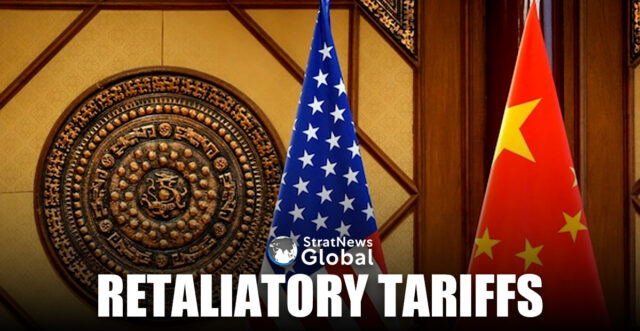China has slapped tariffs on U.S. imports in a swift response to new U.S. duties on Chinese goods, renewing a trade war between the world’s top two economies even as President Donald Trump offered reprieves to Mexico and Canada.
Additional 10% tariff across all Chinese imports into the U.S. came into effect at 12:01 a.m. ET on Tuesday (0501 GMT) after Trump repeatedly warned Beijing it was not doing enough to halt the flow of illicit drugs into the United States.
Within minutes, China’s Finance Ministry said it would impose levies of 15% for U.S. coal and LNG and 10% for crude oil, farm equipment and some autos.
The new tariffs on U.S. exports will start on February 10, the ministry said.
China also said it was starting an anti-monopoly investigation in Alphabet Inc’s Google, while including both PVH Corp, the holding company for brands including Calvin Klein, and U.S. biotechnology company Illumina on its “unreliable entities list”.
Separately, China’s Commerce Ministry and its Customs Administration said it is imposing export controls on tungsten, tellurium, ruthenium, molybdenum and ruthenium-related items to “safeguard national security interests”.
China controls much of the world’s supply of such rare earths that are critical for the clean energy transition.
On Monday, Trump suspended his threat of 25% tariffs on Mexico and Canada at the last minute, agreeing to a 30-day pause in return for concessions on border and crime enforcement with the two neighbouring countries.
But there was no such reprieve for China, and a White House spokesperson said Trump would not be speaking with Chinese President Xi Jinping until later in the week.
During his first term in 2018, Trump initiated a brutal two-year trade war with China over its massive U.S. trade surplus, with tit-for-tat tariffs on hundreds of billions of dollars worth of goods upending global supply chains and damaging the world economy.
“The trade war is in the early stages so the likelihood of further tariffs is high,” Oxford Economics said in a note as it downgraded its China economic growth forecast.
Trump warned he might increase tariffs on China further unless Beijing stemmed the flow of fentanyl, a deadly opioid, into the United States.
“China hopefully is going to stop sending us fentanyl, and if they’re not, the tariffs are going to go substantially higher,” he said on Monday.
China has called fentanyl America’s problem and said it would challenge the tariffs at the World Trade Organization and take other countermeasures, but also left the door open for talks.
The U.S. is a relatively small source of crude oil for China, accounting for 1.7% of its imports last year, worth about $6 billion.
In 2019, Beijing slapped punitive tariffs on U.S. LNG, retaliating for Washington’s increase in tariffs on Chinese goods.
The stakes are higher now, with China importing 4.16 million tons of U.S. LNG in 2024 worth $2.41 billion, nearly double 2018 volumes.
Stocks in Hong Kong pared gains after China’s retaliation, while the dollar strengthened and the Chinese yuan fell, dragging the Australian dollar lower.
“Unlike Canada and Mexico, it is clearly harder for the U.S. and China to agree on what Trump demands economically and politically. The previous market optimism on a quick deal still looks uncertain,” said Gary Ng, senior economist at Natixis in Hong Kong.
“Even if the two countries can agree on some issues, it is possible to see tariffs being used as a recurrent tool, which can be a key source of market volatility this year.”
There was relief in Ottawa and Mexico City after both Canadian Prime Minister Justin Trudeau and Mexican President Claudia Sheinbaum said they had agreed to bolster border enforcement efforts in response to Trump’s demand to crack down on immigration and drug smuggling.
That would pause 25% tariffs due to take effect on Tuesday for 30 days.
Canada agreed to deploy new technology and personnel along its border with the United States and launch cooperative efforts to fight organized crime, fentanyl smuggling and money laundering.
Mexico agreed to reinforce its northern border with 10,000 National Guard members to stem the flow of illegal migration and drugs.
“As President, it is my responsibility to ensure the safety of ALL Americans, and I am doing just that. I am very pleased with this initial outcome,” Trump said on social media.
Canadian industry groups, fearful of disrupted supply chains, welcomed the pause.
“That’s very encouraging news,” said Chris Davison, who heads a trade group of Canadian canola producers.
“We have a highly integrated industry that benefits both countries.”
Trump suggested on Sunday the 27-nation European Union would be his next target, but did not say when.
At an informal summit in Brussels on Monday, EU leaders said that Europe would be prepared to fight back if the U.S. imposes tariffs, but also called for reason and negotiation.
The U.S. is the EU’s largest trade and investment partner.
Trump hinted that Britain, which left the EU in 2020, might be spared tariffs.
Trump acknowledged over the weekend that his tariffs could cause some short-term pain for U.S. consumers, but says they are needed to curb immigration and narcotics trafficking and spur domestic industries.
(With inputs from Reuters)
Delhi based journalist pickled in journalism. Have reported from nine world capitals and almost all parts of India. Over the last three decades, I have worked for India’s mainstream English dailies and contributed to All India Radio, Doordarshan and Women’s Feature Service. Also worked for international media including Japan’s leading newspaper, The Asahi Shimbun and done assignments for The Sunday Times, London, The Telegraph, The Guardian and the Canadian Broadcasting Corporation. Worked in the Embassy of France in New Delhi and can speak French to save my life. Write on Diplomacy, Politics and the social sector. Love Nature, heritage, Nature, animals and vintage cars. Enjoy cycling and playing badminton.





